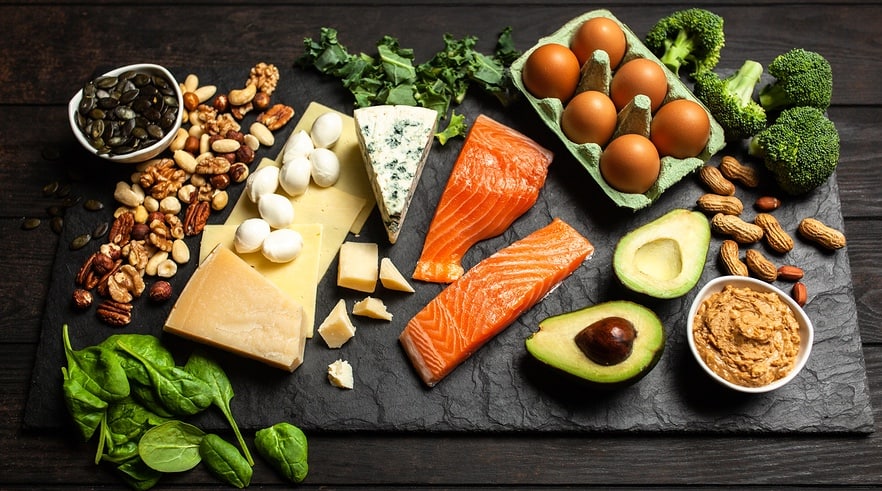The Keto diet hails for dropping pounds, burning more calories, reducing hunger, controlling and managing Diabetes, PCOS, Thyroid, improving blood pressure and lowering cholesterol, as well as triglycerides, and improvement in concentration and alertness too.
The fact that the diet has so much to offer that it makes us revisit to gauge as to how all is this possible? What is the mechanism of the diet, and if does work so wonderfully then how exactly does this diet work? All your (fat-)burning questions, answered.
What Is The Keto Diet?
In a nutshell, it\’s a high-fat, extremely low-carb diet with an \”adequate\” amount of protein thrown in, the keto diet isn\’t new. Developed in the 1920s to treat drug-resistant epilepsy in children, it\’s still used in that capacity today and is being investigated as a potential breakthrough treatment for a range of neurological disorders and diseases. In other words, it\’s not just a celebrity weight-loss trend!
The aim of the keto diet is to put and keep, your body in a metabolic state called ketosis. Our bodies normally burn carbohydrates for energy. When you restrict the number of carbs, the body will break down stored fat, creating molecules called ketones to use as fuel.
Ketosis is a normal physiological process. It\’s just that this particular eating style is keeping your body in that state all the time. Choosing an eating plan or an approach to eating is very personal. Everyone’s body, tastes, and background are unique.
The best approach to food intake is one in which you are healthy and nurtured and which matches your social and cultural preference. If you want guidance, it’s recommended you consult with a registered dietitian.
But Exactly Is Ketosis?
How Much Low-Carb Are We Talking?
There are various versions of the diet, but generally, we\’re talking 75 percent of your daily calories from fat, 20 percent from protein, and 5 percent from carbs.
In real terms, that\’s between 30 and 50 grams of carbs a day. It requires some intricate calculating based on your body fat percentage to figure out the relevant grams of fat and protein. In more real terms, 50 grams of carbs is roughly equivalent to 1 1/4 cups of cooked quinoa. Oh, but sorry, you won\’t be eating any quinoa on this diet.
So basically what we that means is chowing down on a lot of cheese, butter, eggs, nuts, salmon, bacon, olive oil, and non-starchy vegetables such as broccoli, cauliflower, greens, and spinach.
What does a typical day of eating look like?
Here\’s a nutritionist-suggested sample day\’s menu:
For Breakfast:
- 2 eggs fried in butter
- 2 bacon slices
- 3/4 cup spinach
- 1/2 cup mushrooms sautéed in olive oil.
For Lunch:
- 2 ounces of grilled chicken
- 5 cherry tomatoes
- 1 ounce of Monterey Jack cheese
- 2 tablespoons of mayo, all wrapped up in 3 romaine leaves.
For Dinner:
- A 4-ounce baked (with butter) salmon-filled
- Loaded mashed cauliflower
- 2 tablespoons sour cream
- 1 1/2 tablespoons butter, 1 tablespoon of scallions, 1 1/2 ounces of Cheddar, and 1 slice of bacon.
Different Types Of Keto Diet And How They Work
-
The Standard Keto Diet Is the Most Common Version
This is the most common approach to keto and involves sourcing 75 percent of calories from fat, 20 percent from protein, and 5 percent from carbs. That means limiting carb intake to about 20 to 30 grams (g) of carbs per day, Shapiro says. It’s important to note that while this is the keto diet that most people follow.
Who It\’s Best For: People looking to accelerate their weight loss and tap into the other reported health benefits.
-
Targeted Keto Is for Athletes Looking to Improve Their Performance
You’ll follow the keto diet as usual until 30 to 45 minutes before exercise — then it’s time to eat about 25 g of carbs. The idea is that you’ll have just enough carbs to fuel your workout and still be able to return to ketosis easily after you cool down. Choose carbs that are easy to digest (for instance, white bread or white rice) and be sure not to add calories to your daily total — simply redistribute them.
28 days of this version of the keto diet can help to increase some athletic endurance. But researchers added that the diet\’s benefits were mainly seen in short-duration, vigorous-intensity exercise, and that results were inconsistent, so it may not be the go-to approach for all athletes.
Who It\’s Best For: This approach is intended for people who frequently engage in intense, muscle-building workouts. We’re talking high-intensity exercise, like running, swimming, or playing tennis for hours on end. Hitting the gym at a moderate pace a couple of times a week likely won’t cut it.
-
A High-Protein Keto Diet May Be Best for Bodybuilders
This version of keto calls for upping the protein intake just a bit. Protein should make up about 30 percent of calories, with the other 65 percent coming from fat and 5 percent from carbs. Aim to source your protein from both animals (meat, fish, and dairy) and plants (nuts and seeds).
Who It\’s Best For: This is meant for those who need protein to help protect muscle mass, like bodybuilders and older people who need to prevent muscle breakdown. It’s also a good option for those who show signs of a protein deficiency. Those signs include a loss of muscle or thinning hair.
High-protein keto may not be right for you if you’re following the diet for therapeutic reasons. The reason protein is limited at all [in keto] is because the goal in therapeutic keto is to treat epilepsy and to have high ketone levels.
Protein will not kick you out of ketosis if you have a lot, but it will definitely lower the number of ketones in your blood. Since slightly more protein shouldn’t affect your body’s ability to stay in ketosis, this version of the diet delivers the same weight loss benefits as standard keto.
-
A Cyclical Keto Diet (or ‘Keto Cycling’) Could Help You Stick With the Diet
On cyclical keto, you’ll cycle in and out of keto — usually staying on the diet for five days, followed by one or two days with more carbs. The point of keto cycling is to make it easier for someone to follow.
Every five to six days they can have the carbohydrates they’ve been entirely restricting. There’s no set protocol of what your carb days should look like but do not to go overboard because that will make it more difficult for the body to return to ketosis.
Who It\’s Best For: This is intended for those who have a tough time sticking to keto. It can be helpful if someone wants to take a break and have carbs. That may not be easy for everyone.
-
The Lazy Keto Diet Could Be the Easiest Version
The purpose of the so-called “lazy keto” diet is to make keto easier to follow. Counting calories, fat, and protein intake — for some people, that’s all a bit of a hassle. All you track is carbs in lazy keto.
You should still see results that are similar to regular keto, so long as you keep your carb intake low enough and don’t go overboard in the protein department.
As long as carbs stay low enough, which will vary by person but is usually below 50 g a day, one will stay in ketosis. As a result, you’ll be able to see the effects associated with being in the metabolic state.
Who It\’s Best For: This is for those who want to be in ketosis but don’t want to deal with the hassle of tracking calories, protein, and fat.
Lazy keto can also be dangerous if you take it to mean that you sometimes follow a keto diet and sometimes don’t. Ketosis is all or nothing — you’re either in ketosis or you’re not. What concerns us is when people say they’re following a keto diet but not all the way or something along those lines.
This could lead to weight gain and increased blood lipid values if someone just starts eating a high-fat diet and borrowing concepts from ketosis.
-
A Mediterranean Keto Diet May Be a Heart-Healthier Way to Eat
Think of Mediterranean keto as a combination of two popular approaches to eating: sticking to standard keto macro amounts while emphasizing Mediterranean diet elements like fatty fish and olive oil. The main emphasis is on the quality of fats you’ll be eating.
Unlike the standard keto diet, which doesn’t specify which fats to prioritize, Mediterranean keto diets emphasize options like monounsaturated fatty acids, which may help lower LDL cholesterol, and omega-3s that are anti-inflammatory.
Who It\’s Best For: This is for those who want a flexible approach to healthy eating that is sustainable long term, and who want more emphasis on Mediterranean elements like nonprocessed food and high nutrient density. If you’re a huge fan of salmon and sardines, this may be your favorite keto choice.
-
Keto 2.0 Is a Lower-Fat Type of the Standard Diet
The latest revamp of the keto diet is Keto 2.0, which is gaining traction for those who feel the standard keto diet is too restrictive and difficult to sustain in the long run.
With Keto 2.0, the amount of fat is low, while carbs and protein are high. With the idea that you’ll be able to eat a wider variety of carbs. And these include foods such as fruit, vegetables, beans, and whole grains.
Leaner cuts of meat, as well as seafood, are also emphasized in Keto 2.0. The breakdown here is 50 percent fat, 30 percent protein, and 20 percent carbs. In general, this diet allows for more variety when compared with the traditional keto diet.
One caveat is that there doesn\’t seem to be any research yet that indicates this is effective for weight loss.
Who It\’s Best For: This approach is for people who are looking to lose weight. But have a hard time sticking to the very low carb amounts in the standard keto diet. The only effective diet for weight loss is one you can follow long term. Including more carbs may make it easier for some people to follow through on lifelong changes to what they eat.
-
Dirty Keto Is Similar to the Standard Diet but Expands the Menu
Is this diet as fun as it sounds? Depends on whom you ask. The macronutrient distribution in the “dirty keto” approach is the same as in the standard keto plan. The big difference is that the source of these macros can come from any kind of food. Including highly processed and prepackaged meals.
Instead of getting healthy fats and low carbs from almonds, you can hit your macro amounts with pork rinds instead. The main point of dirty keto is that since the macronutrient amounts it follows support a ketogenic state. So, it doesn’t matter where those macros come from.
Who It\’s Best For: This variation is for those who need a high level of convenience. And, lack the time or interest in cooking and meal prep. This may also be the easiest route to follow for those just getting into keto. Since you can stick to keto even when traveling or dealing with a busy schedule. You just need to read package labels carefully rather than going deep into meal planning.
-
Clean Keto Calls for Eating Organic (and Other ‘Healthy’) Versions of Foods
Swinging in the opposite direction of the dirty keto approach is, naturally, clean keto. But it’s not a full 180, because you can still focus on convenience. You also will still stick to the same macronutrient distribution as standard keto.
The difference is that clean keto is based on sourcing the healthiest versions of foods. That means you’ll look for terms like organic, grass-fed, pasture-raised, and cold-pressed.
Who It\’s Best For: This approach is for those who focus on food quality. Just as much as they do on macro tracking. Also, clean keto may involve more financial investment.
Get yourself started today with Customized Diet Plans and Stay tuned for more such ketogenic transformation stories, health content, and recipes! Also, don’t forget to follow us on Instagram for the daily dose of the Keto Lifestyle!









